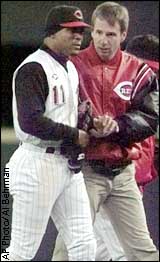 |
|
| | Sunday, April 23 Reds shortstop injured diving for ball | |||||
| Associated Press CINCINNATI -- Reds shortstop Barry Larkin tore a ligament in the middle finger of his left hand while diving for a ball Friday night, sidelining him for up to a month.
"Obviously it's a tough blow," general manager Jim Bowden said. "But if you're going to lose your MVP shortstop, it's better in April than September." It's the second disabling injury this month for the Reds, who had good luck last season. None of their starting eight position players went on the disabled list in 1999, one of the reasons they were able to win 96 games. The streak ended when first baseman Sean Casey broke his right thumb on a grounder in the final exhibition April 1. He was activated Wednesday. "We just got Casey back for a couple of days and now this," said Ken Griffey Jr., who pulled back muscles on a swing Friday but stayed in the game. "It's rough for us. Barry's one of those guys who's been here for a while and you just expect him to be out there." Larkin was placed on the 15-day disabled list. Shortstop Gookie Dawkins will be called up from Double-A Chattanooga to take his spot. Larkin went to his left and dived for Mark Grudzielanek's single up the middle, coming up short. His glove caught on the artificial turf and snapped his hand while his body slid. Larkin got up holding the side of his left hand and wincing in pain. Trainer Greg Lynn ran out to check the injury, and Larkin walked off with him. "It looked pretty bad," said second baseman Pokey Reese, who was closest to Larkin. "You couldn't even see his knuckle. When he comes out, you know it's pretty bad. "You don't want to see him out for even a day, but it's encouraging that it's (only) two-to-four weeks. Barry's a strong man. He'll come back strong." Bowden said the injury was a direct result of the artificial turf, which the Reds wanted to replace this year. The Cincinnati Bengals vetoed the switch. "We should have grass right now and we shouldn't have the injury, but it's out of the Reds' control," Bowden said. The Bengals are scheduled to move into Paul Brown Stadium in August, but general manager Mike Brown was concerned they might have to play two exhibitions at Cinergy Field if construction is delayed. He didn't want a field that's part grass and part infield dirt. Larkin, 35, is off to his best start since 1995, when he won the NL Most Valuable Player award. Larkin singled in his first at-bat Friday, raising his average to .355, and got his 350th career steal. Injuries were Larkin's main problem in the late 1990s. He remained healthy through 1999 and batted .293 with 12 homers and 75 RBI in 151 games, the highest total of his career. He appeared in only 73 games in 1997 -- his lowest total since his rookie season in 1986 -- because of an injured heel that required surgery. In 1998, he overcame neck surgery during spring training to bat .309 in 145 games with 17 homers and 72 RBI.
His best season was 1996, when he batted .298, hit 33 homers,
drove in 89 runs and stole 36 bases. He became the first major
league shortstop to have 30 homers and 30 steals in a season. | ALSO SEE Dodgers rip into Reds 9-2 Reds officials tally $600 shopping tab to replace umps' lost equipment  | |||||
